Manuscript accepted on :
Published online on: 21-12-2015
Magnetically Based Hardware-Software Complex for Wireless Endoscope Capsule Control
Khabibullin Timur, Anpilogov Artem, Shayakov Askar, Konev Vladimir, Lebedev Grigoriy, Tolstaya Anastasia, Shinkarenko Anton
National Research Nuclear University “MEPhI” (Moscow Engineering Physics Institute), Kashirskoe highway, 31, 115409, Moscow, Russian Federation
ABSTRACT: The technology of capsule endoscopy becomes very popular nowadays for its painlessness, effectiveness, usability and uniqueness. In this paper, a magnetically based controllable wireless endoscope capsule is reviewed. A capsule contains magnets in the shape of doughnuts, which enables to control it by means of magnetic setup and control panel. A setup contains superconducting magnet, which provides the high intensity of magnetic field, and this enables to examine patient of any constitution. The external control over the location of a capsule is conducted by the effect of low frequency or even steady magnetic field, which does not have side effect and is able to penetrate freely with biological tissue without significant weakening.
KEYWORDS: control of endoscope capsule by means of magnet; magnetic field; superconducting magnet; magnet coil
Download this article as:| Copy the following to cite this article: Timur K, Artem A, Askar S, Vladimir K, Grigoriy L, Anastasia T, Anton S. Magnetically Based Hardware-Software Complex for Wireless Endoscope Capsule Control. Biosci Biotech Res Asia 2015;12(2) |
Introduction
Lately wireless capsule endoscopy [1-3] is underdoing major changes. Specialized software which enables to diagnose gastrointestinal tract (GIT) pathologies using computer-aided procedures is being developed [4-7]; a capsule is being equipped with more powerful optics and power supply system, the control system of a capsule is being improved [1, 8-10]. The special attention is given to the last aspect because when the capsule goes down the digestive tract only by means of gravity and peristalsis, it sufficiently restricts its clinical application, since the location, posture, speed and retention cannot be controlled.
For instance, the integration of magnet allows a specialist to choose independently alimentary system zones, images of which are necessary for examination. In consequence of the improved procedure, a doctor can examine hard-to-reach and the most critical zones of GIT.
Let us review some scientific publications concerning controlled magnetic capsule. Chen et al. propose a technology that uses an external magnetic field generated by two cuboidal extern permanent magnets to drive the endoscopy capsule with one cuboidal permanent magnet inside [11]. Sehyuk et al. tell about compliant and tetherless magnetic capsule endoscope robot [12].
The patent WO2012110324 A1 describes a method and a device for examining a hollow organ using a magnet-guided endoscope capsule with which video images are generated continuously from the interior of the hollow organ. These video images are evaluated by digital image-processing methods during the navigation of the endoscope capsule in the hollow organ and are automatically analyzed for the presence of diagnostically relevant information, and the result of this analysis is used to control the endoscope capsule [13].
The patent WO2003083880 А1 represents rotating and pivoting magnet for magnetic navigation [14]. The patent EP 1929943 B1 provides a magnetic field generation device, which is capable of varying an orientation of a magnetic field at a target position easily in all directions [15].
Solutions described in these publications for magnet-guided endoscope capsule devices and methods of controlling them differ from the developed experimental model of endoscope capsule controlled by means of external magnetic field. These differences belong to the constructions of capsules and their control systems: the developed capsule includes permanent magnet inside a capsule and at least six autonomously controlled magnetic field sources on each side for external control of a capsule. Each system of “complex” magnet coils consists of several independent magnet coils. This approach enables to guarantee that magnetic field will change more accurately and quickly (in this case magnetic field distribution can be steady and it is possible to guarantee that a capsule will move in right direction and at required speed), fault tolerance of the system increases.
The size of setup is comparable with an MRI (magnetic resonance imaging) scanner. It is worth mentioning that the comparison of the developed setup with an MRI scanner is not correct because medical prescriptions, physical principles of operating, configuration and purposes of both sets are essentially different.
Let us describe in more details the presented hardware-software complex, which provides wireless control of endoscope capsule via external magnetic field for painless selective examination of GIT.
Materials and Methods
Selection of magnetic field source
Magnetic field was selected as the method of capsule control because the external control over the location of a capsule is conducted noninvasively by the effect of low-frequency or even steady magnetic field, which does not have side effect and is able to penetrate freely with biological tissue without significant weakening, because the size of skin-layer (skin effect) [16] is close to the typical size of a human.
To solve the problem of magnetic field creation two essentially different methods were analyzed: magnetic field source based on rare-earth permanent magnets and electromagnet (current flowing in coil block).
The distinctive features of the magnetic system on permanent magnets:
- 5 T magnetic fields in such volume are quite available for modern systems on permanent magnets;
- magnetic field sources with sensible mass-dimensional characteristics (for easy sitting in unprepared hospitals rooms without additional construction effort) enable to create a magnetic field with the volume of 0.5 T in the whole demanded volume;
- though the creation of controllable magnetic field source on the basis of permanent magnets requires complex high precision electric driver for changing magnetic field and consequently for control over the location of a capsule, practically it does not requires attendance.
Electromagnet can be either ordinary (copper wire wound round a coil) or superconducting. The study revealed that there is a principal possibility to create the system of copper coils, and it can operate without cooling system.
The option of using superconducting magnet system contemplates two possible sub-options depending on the material of superconducting wire: low-temperature superconductors (LTS) (work at the temperature of liquid helium 4K or -269 °С) and high-temperature superconductors (HTS), which are capable to work even at the temperature of liquid nitrogen 77K. Superconductor conducts electric current with exactly zero electrical resistance, that is why in this case there is no problem of ohmic heating coil, power consumption (superconducting solenoid may be shorted out and in this case it will consume power only if current is changed) and system weight requirements are also reduced significantly.
Probably, the option of HTS is more profitable, because:
- the prices on high temperature superconducting tape (second-generation superconductors) tend to reduce;
- liquid nitrogen for cooling superconductor is 20-30 times cheaper than liquid helium;
- constructing and exploitation of cryogenic equipment for helium superconductors is much complicated and expensive then for HTS or nitrogen superconductors;
- the possibility to use cheaper cryocoolers for cooling the system.
Configuration and performance of hardware-software complex
The hardware-software complex of control is supposed to fulfill functions described in the following scenario: a patient takes a capsule and takes place in a setup, which controls and directs an endoscope capsule; during the examination, images are transmitted continuously in online mode through wireless channel to scanner and are displayed on a screen for a doctor.
The hardware-software complex of control diagram is introduced in Figure 1.
Therefore, the system is divided in four major blocks:
- endoscope capsule which records and sends images through wireless channel;
- scanner which receives images through wireless channel;
- control system which generates magnetic fields with appropriate configuration;
Operational requirements for endoscope capsule:
- operator’s automated working station of which displays images and transmits control signals to control system.
- frame resolution larger than 640×480 pixels;
- frame rate higher than 2fps;
- view angle wider than 120˚;
- measurement of magnetic field components with a precision better than 1.2 mT;
- measurement of capsule attitude with a precision better than 0.2˚.
The remote control of endoscope capsule by means of magnetic field can be conducted by the application of at least six autonomously controlled magnetic field sources on each side. Each system of “complex” magnet coils consists of nine independent magnet coils. This approach reduces the cost of power supply system of the whole magnet (it is cheaper to use a bid number of commercially available low-current power supplies, which are connected in series, than to develop, engineer and produce solid 300A power supply), enables to guarantee that magnetic field will change more accurately and quickly (in this case magnetic field distribution can be steady and it is possible to guarantee that a capsule will move in right direction and at required speed). Moreover, the fault tolerance of system increases, because if one of circuits breaks down, system capabilities do not change.
Besides, in order to be controllable the setup must have the option of changing magnetic strength of all the three orientations. A capsule can be moved only by creating a magnetic field gradient (it means that the magnetic strength on one side must differ significantly from the magnetic strength on the other side).
The presence of magnetic field gradient enables rotations, movements etc.
A permanent magnet (in the form of a tablet, 12 mm in diameter and 2 mm in width, which is an integral part of this technology) is embedded in an endoscope capsule to allow wireless control of a capsule. It is important to understand that as the size of capsule (free place inside) is limited, magnetic strength created by this permanent magnet is low (0.2T), though it is near to the limits of the used material. As free place inside a capsule is limited, a small permanent magnet and consequently limitations characteristics of the magnetic field created by this magnet are required.
Therefore, a strong external magnetic field is required to control a capsule (to create essential values of strength and external couple, which will move and rotate a capsule inside GIT; these requirements are formulated by gastroenterologists). This magnetic field should be lower than 0.5 T and to guarantee stability and controllability of a capsule, this value must be provided for all three axes (Figures 2 and 3).
The control system must provide the magnetic field configuration essential to move an endoscope capsule in the right way, which means that it must include magnetic field generators (magnetic coils) and controlled current sources, which give current essential to generate the magnetic field. Therefore, an automated working station must interface with current suppliers converting movements of a manipulating device into magnetic field configuration and magnetic field configuration into currents of different suppliers essential for receiving it (each magnetic coil should have its own current supplier to control it independently).
In order to control movements of endoscope capsule, it is essential to provide following degrees of freedom:
- back-and-forth movement;
- right-and-left movement;
- up-and-down movement;
- rotation about principle axis;
- rotation about any axis vertical to principle axis;
Consequently, a manipulating device should provide at least five degrees of freedom.
Software-defined radio is supposed to be used as a scanner. It is a radio transmitter and/or a radio receiver whose technology enables the software to install or change operating parameters of radio frequency (RF), including, in particular, the frequency range, modulation type or output power, except for changing the operating parameters used in the ordinary course of a predetermined operation with the preliminary radio installation according to one or another or system specifications [17], [18]. Using software-defined radio involves partial transfer functions for filtering and demodulation of the radio signal to a personal computer, while the hardware and software defined radio has only a primary band pass filtering and analog-to-digital conversion. Therefore, the technology software of scanner is included in automatic working station.
A capsule, controlled by magnetic field, constantly provides the control system with feedback about its acceleration and rotation force, because the control system must decide on creation or correction of magnetic field.
Because along with the feedback capsule should send large volumes of research data – images, there have been several solutions to optimize the routing of traffic, as shown in the algorithm.
Each frame received by the capsule electronics is in JPEG format, which has a fixed length of header of 688 bytes (686 bytes provided by JPEG standard + 2 non-standard bytes added by image compression chip). As this header is the same for all the frames, it is cut and misses the transmit path.
During the wait operation while an image compression chip performs buffering of images, regular data of accelerometer and gyroscope is sent, providing continuous and regular feedback for control system at this stage.
During sending an image, 128 bytes of images are sent in a series followed by the accelerometer and gyroscope data. Constant 128 was selected basing on the configuration of the endoscope capsule transmission rate, in case of replacement of transceiver chip it should be recalculated according to the following equation:
50 * 10-3 = c⁄trf + tdig,
where C is an unknown constant, and are time of sending 1 byte (block) via radio and digital interface of microcontroller – radio transceiver, and if the time is set for one block, then C will be obtained in blocks (for example, if the standard unit of exchange is 32 bytes, the number of C blocks will be 32 bytes), and if the time is set for one byte, then C is obtained in bytes.
Due to the solutions developed, regardless of the size of a frame and any other external and, in general, non-permanent conditions, the regular feedback will be received with the period of 50 ms.
Moreover, these solutions enable to eliminate the need to supply each transmission of accelerometer and gyroscope data with time stamp, which will save up to 640 bytes per second, thereby increasing the frame rate (of useful information), not less than by 12.5%.
Calculation example: consider the frame size of 5120 bytes or 5 kilobytes, which is average frame size, compressed by JPEG algorithm with native resolution of 640×480, then 640 bytes, are:
640⁄5120 = 0.125 or 12.5%
Figure 4 depicts the algorithm of sending a frame from endoscope capsule to receiver.
The software of operator’s automated workstation must contain the user interface and units responsible for demodulation and filtering data from software-defined radio, separation of images and feedback signals from motion sensors of wireless endoscope capsule, forming control commands for current sources in accordance with feedback signals and signals of manipulator.
In Figure 5 blocks of software to be developed for magnetic capsule system are highlighted in green, main exterior libraries proposed to use are highlighted in orange, external devices for automated work station are highlighted in violet.
GNURadio library, which runs the significant part of mathematical work apparatus with software-defined radio, is selected for the reason that it is the most complete and actively developing solution that maintains a variety of models of software-defined radio, available on the market. It is compatible with both proprietary and open modules of software-defined radio, gives flexibility in choosing hardware solutions and contains all the necessary functions of working with digitized signal.
GNUScience is a set of libraries that provides functions of the solution of differential and integral equations whose solution allows translating signals of controller and feedback into commands for the current sources management system.
QtFramework is a cross-platform set of libraries, which includes regardless interface independent from the current window system.
All exterior libraries, proposed for use at the moment, are actively developing projects that allow to design software on their basis (including commercial), and are cross-platform, which means that they can be assembled in Linux, Windows, MacOSX systems).
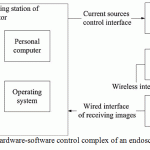 |
Figure 1: Diagram of the hardware-software control complex of an endoscope capsule |
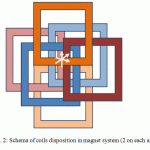 |
Figure 2: Schema of coils disposition in magnet system (2 on each axis) |
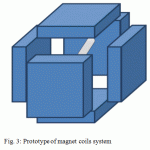 |
Figure 3: Prototype of magnet coils system |
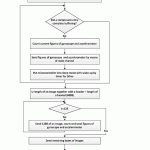 |
Figure 4: Block diagram of the algorithm of sending a frame from endoscope capsule to receiver |
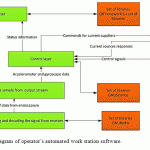 |
Figure 5: Block diagram of operator’s automated work station software |
Results and Conclusion
The advantages of the developed system for controlling the wireless endoscopic capsule are:
- Remote control of capsule movements. An endoscope capsule contains magnets in the shape of doughnuts. These magnetic elements enable not only to fix the location of a capsule, but also to rotate it 360° around its axis.
- Control of capsule movements by means of joystick. A capsule moves in consistence with a manipulating device, which is identical to playing joystick and does not require special skills for working with it.
- The procedure is available for people of any constitution. The operating distance between a setup surface and an endoscope capsule is from 10 sm to 1 m. A superconducting magnet, which is a part of control system, can explain this phenomenon.
- The opportunity to examine patients without anesthesia taking into account possible natural movements during examination.
- Wireless charging of a capsule battery. In case a longstanding examination is required, the battery of a capsule can be charged remotely by means of magnetic coils, one of which is inside a capsule and the other is outside of it.
- The possibility of locomotion through all zones of GIT, including sphincters, which separate GIT sections, and other zones of GIT, which cannot be reached by a gastroscope.
Solutions described in this article enable to cut the cost of device development by using the information about existent scientific developments and the research directions revealed during this work. The materials received can be used also to define advantageous research directions in the field of medical technologies.
It is planned to continue the work on engineering a magnetic capsule, prototyping and testing the effectiveness of its functioning.
Acknowledgment
The publication is prepared in accordance with the scientific research under the Agreement between “Mobile informatics” (LLC) and Ministry of Education and Science of the Russian Federation № 14.579.21.0053 от 23.09.2014. Unique project identification number is RFMEFI57914X0053.
References
- de Francis, B.S. Lewis, D.S. Mishkin. Capsule endoscopy in understandable language / trans. from English. Ed. E.D. Fedorov, E.V. Ivanova. – M: Practical medicine, 2012. – 128 p.: Ills.
- Iddan, Gavriel; Meron, Gavriel; Glukhovsky, Arkady; Swain, Paul. Wireless capsule endoscopy. Nature, Volume 405, Issue 6785, pp. 417 (2000).
- Nakamura T, Terano A. Capsule endoscopy: past, present, and future. J Gastroenterol. 2008;43:93–99.
- Mikhaylov Dmitry, Zhukov Igor, Konev Vladimir, Starikovskiy Andrey, Khabibullin Timur, Tolstaya Anastasia, Kukushkin Alexander. Review of features and metafeatures allowing recognition of abnormalities in the images of GIT. 17th IEEE Mediterranean Electrotechnical Conference (MELECON), 2014. 13-16 April 2014. Pages: 231 – 235.
- Dongmei Chen, Meng, M.Q.-H.; Haibin Wang; Chao Hu; Zhiyong Liu. A novel strategy to label abnormalities for Wireless Capsule Endoscopy frames sequence. Information and Automation (ICIA), 2011 IEEE International Conference.
- Dmitry Mikhaylov, Andrey Starikovskiy, Vladimir Konev, Andrey Grigorenko, Larisa Shustova. Review of software for automated analysis of digestive tract images. Biosciences Biotechnology Research Asia, December 2014. Vol. 11(3), p. 1109-1114.
- Alexander Kukushkin, Mikhaylov Dmitry, Ekaterina Ivanova, Evgeny Fedorov, Zhukov Igor, Semenov Sergey, Tolstaya Anastasia, Rami Muleys, Starikovski Andrey. Recognition of Hemorrhage in the Images of Wireless Capsule Endoscopy. The 16th IEEE Mediterranean Electrotechnical Conference MELECON 2012. Рр 899-902.
- Lee, C.; Choi, H. ; Go, G. ; Jeong, S. ; Ko, S.Y. ; Park, J. ; Park, S. Active Locomotive Intestinal Capsule Endoscope (ALICE) System: A Prospective Feasibility Study. Mechatronics, IEEE/ASME Transactions on (Volume: PP, Issue: 99), 2014. Pages: 1 – 8.
- Alonso, O.; Freixas, L. ; Canals, J. ; Susilo, E. ; Dieguez, A. Control electronics integration toward endoscope capsule robot performing legged locomotion and illumination. IEEE/RSJ International Conference on Intelligent Robots and Systems (IROS), 2010. Pages: 2798 – 2803.
- Dmitry Mikhaylov, Timur Khabibullin, Igor Zhukov, Andrey Starikovskiy, Landish Gubaydulina, Natalya Romanchuk and Vladimir Konev. Development of Retention System of the Autonomous Endoscope Capsule and Its Functionalities. BIODEVICES 2014. Proceedings of the International Conference on Biomedical Electronics and Devices. ESEO, Angers, Loire Valley, France. 3 – 6 March, 2014. Pages 77-84.
- Guangzeng Chen; Xun Wang; Yunjiang Lou. Modeling and simulation of magnet-guided active endoscope capsules manipulated by robots. IEEE International Conference on Information and Automation (ICIA), 2014. Pages: 881 – 886.
- Sehyuk Yim, Sitti, M. Design and analysis of a magnetically actuated and compliant capsule endoscope robot. IEEE International Conference on Robotics and Automation (ICRA), 2011. Pages: 4810 – 4815.
- Stefan Förtsch, Aleksandar Juloski, Henrik Keller, Philip Mewes, Dominik Neumann. Verfahren und einrichtung zur untersuchung eines hohlorgans mit einer magnetgeführten endoskopkapsel. Patent WO 2012110324 A1, pub. date 23 Aug 2012.
- Francis M Creighton Iv. Rotating and pivoting magnet for magnetic navigation. Patent WO 2003083880 A1, pub. date 9 Oct 2003.
- Kentarou Horisaka, Hisato Amano. Magnetic field control method and magnetic field generation device. Patent EP 1929943 B1, pub. date 17 Apr 2013.
- Vander Vorst, Andre; Rosen, Arye; Kotsuka, Youji. RF/Microwave Interaction with Biological Tissues, John Wiley and Sons, Inc., 2006.
- Galkin V.А. Basics of software-configurable radio. – Moscow.: Goryachaya liniya – Теlekom, 2013. – 372 p.
- Markus Dillinger, Kambiz Madani, Nancy Alonistioti. Software Defined Radio: Architectures, Systems and Functions. Wiley, 2003. 454 pages.

This work is licensed under a Creative Commons Attribution 4.0 International License.





